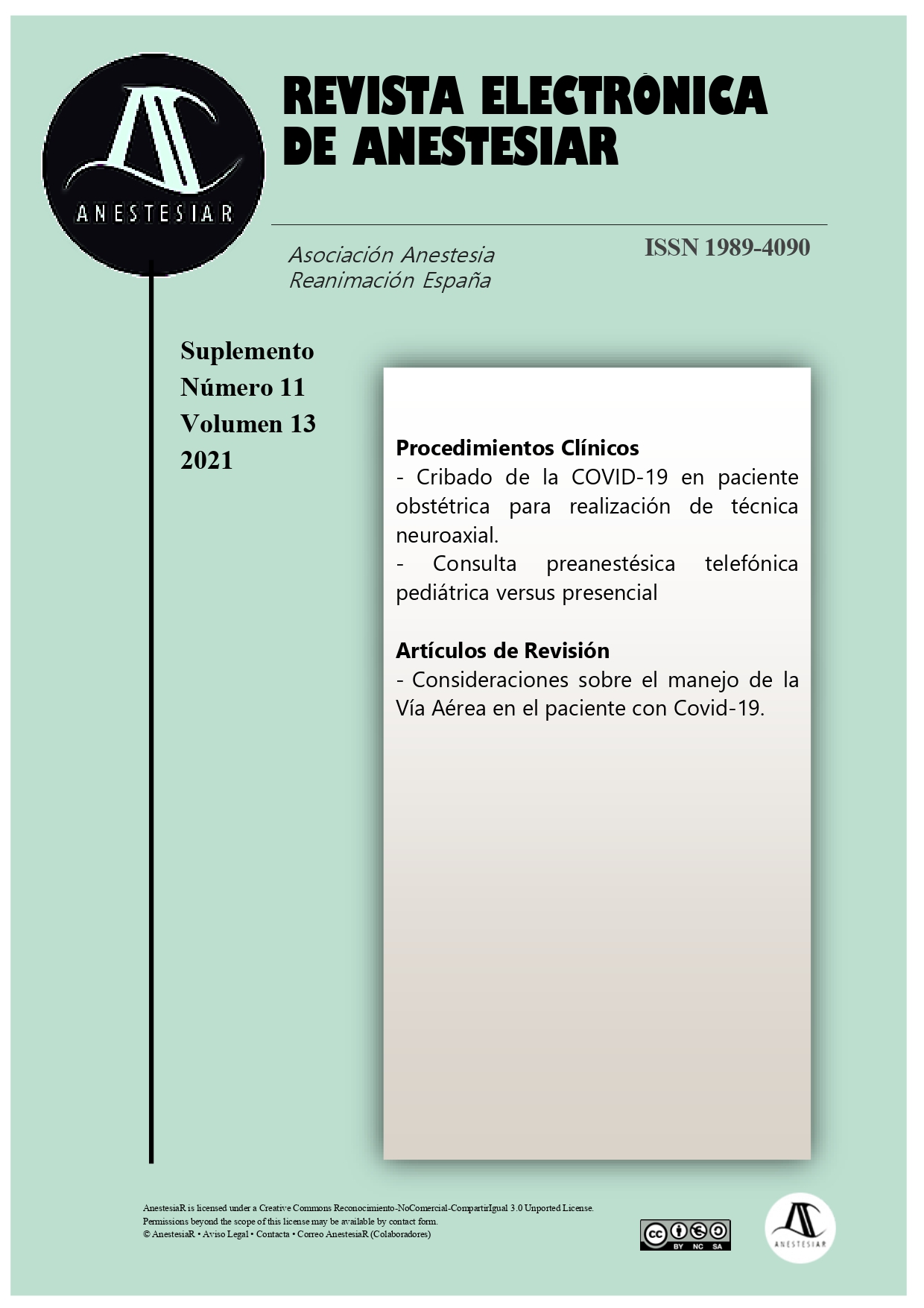Airway management considerations in patients with covid - 19
DOI:
https://doi.org/10.30445/rear.v13i11.1020Keywords:
airway management, endotracheal intubationAbstract
Endotracheal intubation in patients with COVID - 19 is considered a high risk procedure for medical staff and for the patients. It is essential to perform this practice the safest way.
During airway management several techniques that potentially generate aerosols are involved and can create an increased risk of transmission of infection. All the staff must wear a proper protection equipment. Clear communication and organization prior to the procedure is of vital importance, especially when the patient has a suspected difficult airway. Adequate preoxygenation may delay hypoxaemia during tracheal intubation and may decrease the need to hand ventilate. The use of videolaryngoscopy has become more important, since used by expert hands is the device that most likely will help achieve success at first attempt. Moreover it ensures some distance between doctor and patient. Tracheal extubation must also be carefully planned as it is considered a high risk procedure.
An extensive research has been carried out in the literature available on the subject, limiting itself to international articles published in the last year, available in the data base Pubmed and Embase using the key words: airway management, COVID - 19, endotracheal intubation.
References
(1) Cook TM, El-Boghdadly K, McGuire B, McNarry AF, Patel A, Higgs A. Consensus guidelines for managing the airway in patients with COVID-19: Guidelines from the Difficult Airway Society, the Association of Anaesthetists the Intensive Care Society, the Faculty of Intensive Care Medicine and the Royal College of Anaesthetists: Guidelines from the Difficult Airway Society, the Association of Anaesthetists the Intensive Care Society, the Faculty of Intensive Care Medicine and the Royal College of Anaesthetists. Anaesthesia. 2020;75(6):785–99. DOI: 10.1111/anae.15054.
(2) Meyerowitz EA, Richterman A, Gandhi RT, Sax PE. Transmission of SARS-CoV-2: A review of viral, host, and environmental factors. Ann Intern Med. 2021;174(1):69–79. DOI: 10.7326/M20-5008
(3) Pascarella G, Strumia A, Piliego C, Bruno F, Del Buono R, Costa F, et al. COVID-19 diagnosis and management: a comprehensive review. J Intern Med. 2020;288(2):192–206. DOI: 10.1111/joim.13091
(4) Brewster DJ, Chrimes N, Do TB, Fraser K, Groombridge CJ, Higgs A, et al. Consensus statement: Safe Airway Society principles of airway management and tracheal intubation specific to the COVID-19 adult patient group. Med J Aust. 2020;212(10):472–81. DOI: 10.5694/mja2.50598
(5) Cook TM, McGuire B, Mushambi M, Misra U, Carey C, Lucas N, et al. Airway management guidance for the endemic phase of COVID-19. Anaesthesia. 2021;76(2):251–60. DOI: 10.1111/anae.15253
(6) Zuo M-Z, Huang Y-G, Ma W-H, Xue Z-G, Zhang J-Q, Gong Y-H, et al. Expert recommendations for tracheal intubation in critically ill patients with Noval Coronavirus disease 2019. Chin Med Sci J. 2020;0(0):0. DOI: 10.24920/003724
(7) Thiruvenkatarajan V, Wong DT, Kothandan H, Sekhar V, Adhikary SD, Currie J, et al. Airway management in the operating room and interventional suites in known or suspected COVID-19 adult patients: A practical review: A practical review. Anesth Analg. 2020;131(3):677–89. DOI: 10.1213/ANE.0000000000005043
(8) Sullivan EH, Gibson LE, Berra L, Chang MG, Bittner EA. In-hospital airway management of COVID-19 patients. Crit Care. 2020;24(1):292. DOI: 10.1186/s13054-020-03018-x
(9) Yang M, Dong H, Lu Z. Role of anaesthesiologists during the COVID-19 outbreak in China. Br J Anaesth. 2020;124(6):666–9. DOI: 10.1016/j.bja.2020.03.022
(10) Aziz MF. The COVID-19 intubation experience in Wuhan. Br J Anaesth. 2020;125(1):e25–7. DOI: 10.1016/j.bja.2020.04.058
Downloads
Published
How to Cite
Issue
Section
License
Copyright (c) 2021 Revista Electrónica AnestesiaR

This work is licensed under a Creative Commons Attribution-ShareAlike 4.0 International License.
 Envío y derechos de autor
Envío y derechos de autor


 Revista Electrónica AnestesiaR by
Revista Electrónica AnestesiaR by 